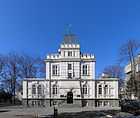Belgrade Observatory
| Belgrade Observatory | |
|---|---|
|
Pavilion of Large Refractor | |
| Code | 057 |
| Location | Zvezdara, Belgrade, Serbia |
| Coordinates | 44°48′13″N 20°30′48″E / 44.80361°N 20.51333°E |
| Altitude | 253 m |
| Established | 1887 |

Belgrade Observatory is an astronomical observatory located in the eastern part of Belgrade, Serbia, in natural environment of Zvezdara forest.
In 1879, Milan Nedelkovic received a scholarship to continue his education in Paris at the Sorbonne. He studied mathematics and at the College de France extraordinary studying physics. In Paris observatroy was formed the first School of Astronomy, which Nedeljkovic successfully completed. During the study he also finished courses in meteorology, precision mechanics and seismology. After five years of study in Paris, he returned in 1884 in Belgrade where he became a professor of astronomy and meteorology at the Grand School (University of Belgrade). At the same time launching a campaign for the establishment of observatory at Grand School, but was rejected because of financial circumstances. Finally, after three long years, the decree of the founding of the Observatory was signed on 26 March 1887 by the Minister of Education and Church Affaires of Kingdom of Serbia Milan Kujundzic on the initiative of professor Nedeljkovic.[1]
Nedeljkovic was appointed first director of the newly founded Observatory. On 1 July 1887 Nedeljkovic started his activity at the provisory astronomical and meteorological observatory in the rented Geizler family's house. Adopting the justified request of Prof. Nedeljkovic, a new Minister of Education, Dr Vladan Djordjevic passed on September 27, 1888 the Regulation on the establishment of unified network of meteorological stations across the country. Then Observatory becomes Central meteorological station for data collection. In the rented house Observatory was operating until 1 May 1891, when it was moved into its own building constructed. It was constructed according to the design of architect Dimitrije T. Leko and equipped with the most modern instruments for astronomical and meteorological observations. Also, then are made in funcion two astronomical pavilion. Apart from its importance for astronomy and meteorology, the newly built Observatory, headed by Nedeljkovic, was a cradle of the seismic and geomagnetic researches in Serbia. Thanks to Nedelkovic′s colleague and friend Miklós Konkoly, the founder of modern Hungarian astronomy and meteorology, the observatory was equipped with an seismograph. Meanwhile, for a short time, from July 1899 to October 1900, as second person on the head of Observatory was Đorđe Stanojević.[2][3]
In 1924, by ruling of the Faculty Council the Observatory was divided into two separate institutions: Astronomical Observatory and Meteorological Observatory of Belgrade University. At the head of the Astronomical Observatory was appointed in 1926 Vojislav V. Miskovic, at the time already a well established astronomer engaged at Nice Observatory, France.[4] In 1929 Miskovic succeeded in getting funds for the constructions of a new, modern, observatory, at 6 km distance southeast from the city's centre, occupying a 4.5 ha area at 253 m high hill on Veliki Vracar.[5] It was built between 1929 and 1931, after the design by architect Jan Dubovi.[6] It was complex with the Administrative building and pavilions with astronomic equipment. The Observatory was designed in modernist style, with elements of academic historicism, characteristic of the inter-war period. In addition to the Administrative building were erected Pavilion of the Small Meridian Circle, Pavilion of Large Refractor ″Carl Zeiss″ 650/10550 mm, Pavilion of Small Refractor, Pavilion of Astrograph Zeiss 160/800 mm, tower - building with water tank, building with a mechanic and carpenter’s workshop. From the end of 1957 until the end of 1959, three new observation pavilions were built - Pavilion of Large Vertical Circle Askania 190/2578 mm, Pavilion of Large Transit Instrument Askania 190/2578 mm and Pavilion of Large Meridian Circle Askania 190/2578 mm.[7] Observatory is organization with more about 52 employees, of which 39 are researchers.
Mt. Vidojevica
Construction of the new Astronomical Station of the Belgrade Observatory infrastructure began at the summit of Mountain Vidojevica (elevation 1155m) in southern part of Serbia. The 60-cm Cassegrain telescope was installed at Station in spring of 2011.[8] The new telescope is named “Nedeljkovic”, after Milan Nedeljkovic, the first director and founder of the Observatory. In the next phase, a 1.5m-class fully robotic telescope will be installed at Astronomical Station of Vidojevica.[9] It will be named “Milankovic”, after Milutin Milanković, a geophysicist, civil engineer and astronomer who was the director of the Observatory from 1948 to 1951.[10] Telescope “Milankovic” will be part of the World-wide Network of Robotic Telescopes.
Directors
- Milan Nedeljković (1887 - 1899)
- Đorđe Stanojević (1899 - 1900)
- Milan Nedeljković (1900 - 1915)
- Victor Conrad (1916 - 1918)
- Milan Nedeljković (1919 - 1924)
- Milutin Milanković (1925 - 1926)
- Voyislav Mishkovitch (1926 - 1946)
- Milorad B. Protić (1946 - 1948)
- Milutin Milanković (1948 - 1951)
- Vojislav Mišković (1951 - 1954)
- Milorad B. Protić (1954 - 1961)
- Vasilije Osekan (1961 - 1965)
- Petar Đurković (1965 - 1970)
- Milorad B. Protić (1971 - 1975)
- M. Mijatov (1975 - 1981)
- Miodrag Mitrović (1982 - 1989)
- Istvan Vince (1990 - 1993)
- Milan Dimitrijević (1994 - 2001)
- Zoran Knežević (2002 -)
See also
| Wikimedia Commons has media related to Belgrade observatory. |
References
- ↑ Astronomical Observatory by Sasa Mihajlov
- ↑ Đorđe Stanojević in works of Jules Janssen
- ↑ They built Serbia – Đorđe Stanojević
- ↑ The Notes on Vojislav V. Mišković
- ↑ Astronomical Observatory by Sasa Mihajlov
- ↑ Astronomical Observatory by Sasa Mihajlov
- ↑ Obituary Milorad B. Protic
- ↑ Future Robotic observatory on Mountain Vidojevica:site and equipment specification
- ↑ “Future science with metre-class telescopes” Dr. Milan Bogosavljević
- ↑ Future Robotic observatory on Mountain Vidojevica:site and equipment specification